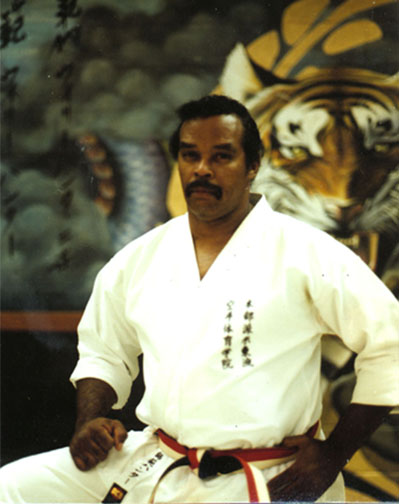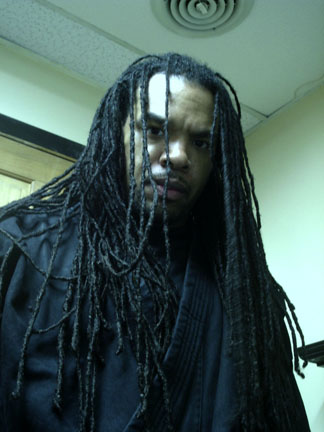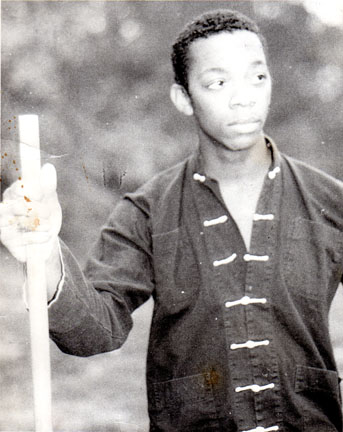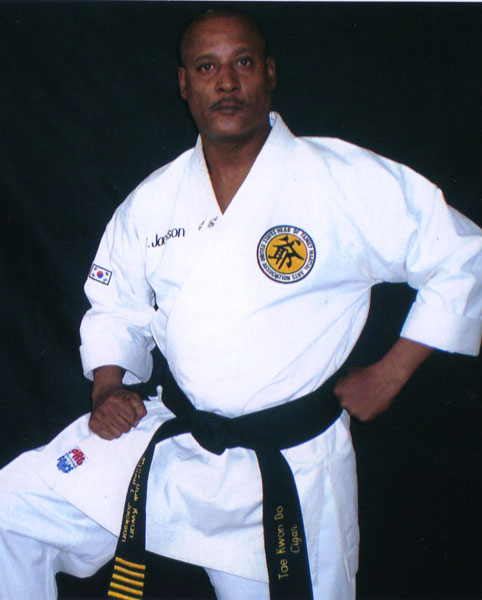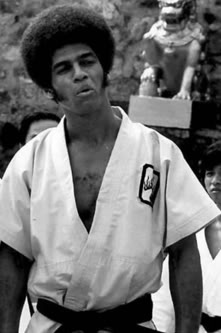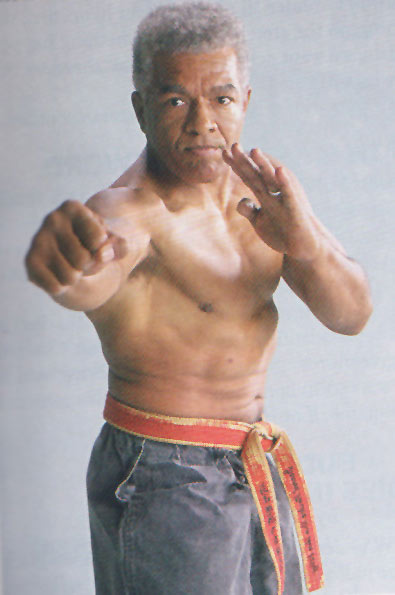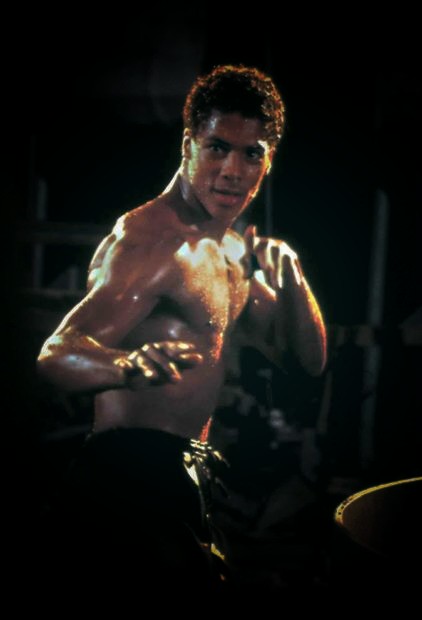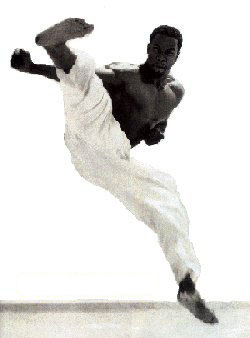 |
Tribute to Black Martial Artists
Under Construction
To Donate to the Young Tiger Educational Fund Click Here
Please come back and visit for Summer updates.
Kiyoshi Willie Hunter Sr |
Kiyoshi Hunter started training in the art of Judo at the age of 13. As a young teenager, his mother felt that martial arts was a great way for Kyoshi to stay out of trouble, learn how to protect himself, and learn the value of personal development. During his studies of the martial arts, Kyoshi studied and achieved Black Belts in Moo Do Kwan, Jiu Jitsu, Karate and Judo. As an adult with over 50 years of martial arts experience, Kyoshi understood the importance of teaching practical selfdefense and how one could develop personally through proper guidance. He wanted to share this gift with children and adults. The first TIGER Martial Arts Academy started in the front yard of Kyoshi’s home. The Academy was founded in 1968 by the late Kyoshi Willie R. Hunter Sr. He would train anyone who wanted to learn. In time TIGER evolved from the yard, to recreation centers, to old buildings and to its current location. Kyoshi Hunter died May 25, 2005. He never got the chance to see the Tiger Martial Arts 7,200 sq ft building his sons Willie and Jeffrey Hunter built in honor of his dedication to God, his family and students.
|
Shihan Willie Hunter Jr |
Willie Hunter started training martial arts at the age of 3 years old under the tutelage of his father, Willie R, Hunter Sr. Mr. Hunter has been studying martial arts for over 30 years. Throughout his martial arts training, Mr. Hunter has also had the opportunity to work with and study under, Soke Kuniba, Brian Manna, Guru Richard Bustillo, Ajarn Chai Sirisute, Pedro Sauer, Frank Cucci, Phil Miligaresse and Harold Hankins. During his early years in the martial arts, Mr. Hunter was a national competitor. One of Mr Hunter memorial competitions was the Ed Park International Championships. This Martial Arts Championship was made famous by the late Bruce Lee. Mr. Hunter placed 1st in the nation at this event. Today, Mr. Hunter enjoys teaching, training, and mentoring his students and instructors. Mr. Hunter is often enlisted by the public and private school systems to speak on the topics of discipline, confidence, goal setting and the importance of a good education.
|
Shihan Jeffrey Hunter |
Jeffrey Hunter started training martial arts at the age of 5 years old under the tutelage of his father Willie R Hunter Sr. Jeffrey Hunter is a 4th degree Black Belt and the Head Instructor of TIGER Youth and Adult Striking Programs. Mr. Jeffrey Hunter has trained and studied under Dan Inasanto, Ajarn Chai Sirisute, Soke Kuniba, Eric Paulson, Guru Richard Bustillo and Harold Hankins. Jeffrey Hunter enjoys studying Thai Boxing, Karate, Kali, and Jiu Jitsu. Mr. Hunter’s passions for the martial arts and the personal growth of his students, is what drives him to development himself so he may continue to impact others.
|
Professor Willie Cordy Jr |
Professor Willie C. Cordy Jr trained in Atlanta at the “Tai Chi Association” in Decator Georgia under Master Chong. There he studied Traditional Shaolin Kung Fu. Atlanta Georgia is where he earned the name "Young Dragon". Cordy had the fastest feet around. His long extention of his legs helped in his whipping of the tail. Later Cordy had the privalage of teaching the childrens classes in Kung Fu. This was an honor he felt he earned for his hard work. Emergencies later in the family put his studies on hold. Cordy had to leave the city and his school he loved for family responcebilaties. Cordy returned to the streets of his birth place, Portsmouth Virginia. These are some of the streets that helped mold him into the person that he is. Cordy was born and raised in Portsmouth, it was in the streets of Portsmouth (P-Town) with his friends that Cordy learned how hard life could be. The moral upbringing from his mother and father, and the streets of Portsmouth during the early 80's is what kept him on his toes. After two tragic accidents and years of recovery, Professor Cordy is on his feet and working with his young son in art and the studies of martial arts. Cordy continues his studies at Tiger Martial Arts Academy under Willie Hunter Jr in the art of strategy and conditioning while caching his only son Willie "Young Tiger" Cordy III. Cordy coaches his son in strategy training for competion fighting at Tiger. The dynamic duo also train together at the Wing Chun Kung Fu School in Virginia Beach under the tutalage of Sifu Gorden Lu, son of Lo Man Kam and great nephew of Master Ip Man.
|
Grand Master Harold Hankins
|
It was a long, torturous, fascinating journey. It was perilous road congested with prodigious pitfalls, and intriguing turns. Phenomenal is the man capable of surviving such an expedition. Harold Lee Hankins not only survived this road, he conquered it. As a young man, Harold Hankins was thrust into boxing. His teacher, Roy Luson, was five times heavyweight champion of the Navy; only an injured hand prevented this knockout specialist from representing the USA in the 1956 Olympics. Luson built an elite core of young amateur boxers, which included Hankins. So viciously effective were these “farmers,” that they were banned from any further fights with the Navy’s champion pugilists. Sensing there was more to fighting, Harold Hankins sought out qualified Masters in the Asian fighting arts. He wrote letters, made telephone calls, and traveled to meet them. He recruited and petitioned membership to build a school. The odds against him often seemed insurmountable. Once he a found a Judo school and applied for membership. The Instructor blatantly insulted Hankins by telling him his race of people were inferior, unable to grasp and endure the training. “We find colored people lack the culture to learn this discipline,” he was informed. Disappointed—but not discouraged, determined to learn Martial Arts, start his own school, and open its doors to any and all with a desire to train, Harold Hankins continued studying and traveling many miles, sacrificing pleasure for his principle. He opened the first Karate school in Norfolk, Virginia. Many world renown Masters contributed to this unique and profound school. Some of the teachers are in the Black Belt hall of Fame. Some were sadistic, brutal, ruthless, unsympathetic, intolerant of mistakes, or just downright mean. Sometimes Harold Hankins traversed lengthy stretches of lonely highways and waited endless hours in empty hallways for classes to begin. He endured “No Pity Nights”; classes in which even the teacher suffered broken bones. He endured horrors of training and drilling which would give Freddy Kruger nightmares. Few pulled through these panic filled classes of agony. Those who did are to be revered. His Master instructors were trained in the old tradition. They honed their skills on battlefields. Some had killed numerous men. A spectacular collection of Korean Masters, Japanese Masters, Chinese Masters, CIA Agents, and authors of Martial Arts books, were these internationally recognized Martial artists. Harold Hankins persevered and mastered the techniques taught to him by this illustrious roster. The diversity of their styles and methods created a monster in the eyes of the Martial Arts community. Mere mention of his name was cause for alarm. Only those with the warrior’s spirit were capable of training with him. The Judo school, which originally refused him membership, asked him to return and teach On August 16, 1969, Master Ki Whang Kim granted Mr. Hankins, along with fellow black belts, Leon Nicholson and Gaylord Patterson, permission to teach Korean Karate. Thus was born the Authentic Karate Club, borrowing on the name of the Authentic Jiu-Jitsu Club in which he previously trained. So from the expertise and proficiency he received in boxing from Roy Luson; Judo & Jiu-Jitsu for LT. Charles O. Neal; Pa Kua and Hsing-I form Robert Smith; Aikido from Akio Mitake and Nebuhiro Hayashi; Tang Soo Do from Ki Whang Kim and Albert Cheeks; Tae Kwon Do from Kwang Hyung Kim, Ilhoi Kim and Jong Kwan Park; Wing Chun King Fu from Shiu Hung Leung and Dave Meadows; and Motobu Ha Shito-Ryu from Shiyogo Kuniba, Harold Lee Hankins created a devastating system. From The Wrecking Crew, to the Wild Bunch, to the Bulala Bunch, 537 West 35th Street in Norfolk, Virginia was truly a House of Warriors. Those with the patience to stay and receive the proper training built character and became champions. Students under his command changed the face of tournaments in this area forever, bringing about revisions of rules, annihilation of certain divisions, and the proliferation of closed tournaments. “When I speak—you function!” he was often heard saying to sweating and struggling students. Devotedly they practiced his preachings. Flawless technique was the goal. The by-products were strength of character, discipline, clarity of thought, confidence, patience, leadership qualities, deductive reasoning, pride of self, and winning—in anything. “If you stay with me, and do like I tell you, you can go anywhere in the world”, he often prophesied. “You might not speak the language. You might not know his forms. But you’ll be able to fight—with anyone.” His students have been victorious in Asia, Europe, the Caribbean, North, and South America. Wherever they went, people wanted to know, “Who taught you?” The students of Harold Hankins have stood with the best of them, and stood over the rest of them. It is one thing to learn Karate. It is another thing to become Karate. Harold Lee Hankins and his black belts epitomize this thought. His teachings have permeated every aspect of their varied lives. He has taught federal and local government agents, ministers, doctors, lawyers, actors, police officers, soldiers, Muslims, Christians, Jews, Blacks, Whites, Asians, Hispanics, and anyone else with the desire to learn his ancient techniques manifested by modern methods. Those who were fortunate enough to thrive under the hand that managed “the stick” or suffered “the block” will never forget HIS NAME, or the lessons he endeavored to instill in us. He gave us his heart. We have witnessed, on countless occasions, his students defeating not only the students of other Masters, but the Masters themselves. I personally can testify that I saw globally recognized Masters retreat from the challenge to battle a most willing Harold Hankins. I have seen this walking Martial Arts encyclopedia mesmerize audiences, contenders, and pretenders with his vast knowledge, wisdom, and understanding of the arts and warriors. As time marches relentlessly forward, many of those Master instructors, which taught Harold Lee Hankins, are no longer with us. Their spirit remains with us, however, and they look on with pride and honor at the achievements of their pupil. Usually, to move up in a rank, the teacher promotes the student. But this is a case of the students acknowledging the teacher. In recognition of the history of Harold Lee Hankins and the legacy he created, the Board of Black Belts of the Authentic Karate Club distinguish our Teacher/Father as Grandmaster Harold Lee Hankins, Founder of the 35th Street Karate System. Bulala. |
Master Michael L. Cigar Jackson |
Under Construction
|
Jim Kelly
|
Kelly was born in Paris, Kentucky. He began his athletic career in high school, competing successfully in basketball, football, and track and field. He attended the University of Louisville where he played football, but left during his freshman year to begin studying Shorin-ryu karate. Additionally, he trained in Okinawa-te karate under the direction of Shihan Gordon Doversola. Kelly won the Huntington Beach Classic and credits Doversola with making him a world class fighter. During this time other notables as Joe Lewis would also train in the same dojo (martial arts school). After winning the middleweight title at the 1971 International Middleweight Karate Championship in Long Beach, he opened his own dojo. He taught karate to actor Calvin Lockhart for a role in a thriller feature film Melinda; he ended up playing a martial arts instructor in the movie. As an actor, Kelly is best known for co-starring alongside Bruce Lee in Enter the Dragon. This appearance led to starring roles in a string of martial arts-themed blaxploitation films, among them Melinda and Black Belt Jones. Most of Kelly's film roles played up the novelty of an African-American martial arts master.
|
Shidoshi Ron Van Clief
|
Grand Master Ron Van Clief has trained and taught Martial Arts well over 40 years. He has appeared internationally on television and radio demonstrating his art, as well as at many colleges and universities lecturing and presenting the Ron Van Clief 101 curriculum. He holds a black belt or the equivalent in Karate, Ju-Jitsu, Aiki-Jitsu, Kung-Fu, Arnis de Mano and Zen Jutsu. Further he is a master of the Sword, Sai, Nunchaku and other martial arts weapons. Grand Master Van Clief is a 10th Degree Red Belt and founder of the Chinese Goju System, with the title "Shidoshi". Ron Van Clief has established more than 25 schools in over 18 countries. He has starred, choreographed, appeared, or assumed roles as stunt man in more than forty motion pictures. He served as a policeman in New York and served several years as a United States Marine. Shidoshi Van Clief, is formerly commissioner of the World Contact Karate League. Ron Van Clief continues to bestow his knowledge with his remote instructors and students via seminars and through books and video. He has competed in more than 900 tournaments during forty years of international competition. He continues to compete in the "All American Annual Championships" held in New York, and most notable, he's a 5 times World Champion. In 1994 he fought in the Ultimate Fighting Championship IV, at the age of 51 against the undefeated Champion Joyce Gracie. Grandmaster Ron Van Clief competed in many brutal full contact matches in Asia to prove his systems effectiveness to the world of Martial Arts.. While living in the Caymen Island, he was the Chief Instructor for the Royal Cayman Island Police Department. In 1995, he was inducted into the World Martial Arts Hall Fame, with the Life Time Achievement Award. In 2002, he was inducted in the Black Belt Hall of Fame. |
Taimak
|
Taimak (pronounced Tie-Mock) Guarriello (born June 27, 1964) is a martial arts actor and stuntman, best known as Leroy Green in the 1985 martial arts film The Last Dragon. He was born in New York, to an African American mother, and an Italian father. Taimak got his first taste of martial arts at the age of 6 years old under the instruction of Master Gerald Orange, a Japanese Goju stylist. After the devorce of his mother and father, Taimak lived with his father in New York. He began studying Chinese Gojo with world renowned fighter and kung fu movie star Ron Van Clief. Taimak went on to win a New York State Kickboxing title and trained under Van Clief for the next ten years reaching the level of seventh degree Black Belt. At this time everyone was talking of the movie "The Last Dragon". Taimak's leading role in Berry Gordy’s The Last Dragon, in which he played Leroy Green, a Bruce Lee-inspired martial artist in search of "The Glow", was his first major break in acting. The film was a financial success and grossed more than $25 million at the box office. Since The Last Dragon, Taimak has appeared in a number of TV roles and over a dozen plays. Taimak later appeared in a number of TV roles and music videos including the lead male in Janet Jackson's "Let's Wait Awhile" music video, Debbie Allen's "Special Look" video. He played a date rapist on an episode of the TV show A Different World. He also appeared in 36 Crazyfists' music video "Bloodwork". Taimak has also worked with a number of celebrities including Madonna and starred in the play Cheaters, which toured the United States. He also starred in a hit Off-Broadway show in 2004 called Roadhouse The Comedy, based on the Patrick Swayze film Road House. In addition to his acting career, Taimak operates a gym on the Manhattan's East Side in New York city called Fitness Concepts, which he opened in 2002. |
Michael Jai White |
Michael Jai White (born November 10, 1967) is an American actor and martial artist who has appeared in numerous films and television series. He is the first African American to portray a major comic book superhero in a major motion picture, having starred as Al Simmons, the protagonist in the 1997 film Spawn. White appeared as Marcus Williams in the Tyler Perry films Why Did I Get Married? and Why Did I Get Married Too?, and currently stars as the character on the TBS comedy-drama television series Tyler Perry's For Better or Worse. White was born in Brooklyn, New York and moved as a teen to Bridgeport, Connecticut, where he graduated from Central High School in 1988. He is an accomplished martial artist, holding seven black belts in Shotokan, Tae Kwon Do, Kobudo, Goju Ryu with renowned Master Eddie Morales, Tang Soo Do, Wushu and Kyokushin, with a specific focus in Kyokushin (although his style incorporates aspects of many different martial arts forms). White started martial arts training at the age of eight. White is a former teacher. He cites his history in education as the reason why, despite his personal love for the music genre on "a lot of levels", he cannot "in good [conscience]" have a positive opinion on hip hop or "excuse some of [its] pervasive and destructive elements", due to his experience with youngsters who had difficulty seeing the difference between it and real life.
|
All Photography and Graphics copyrights of Cordy Studio 2011. All rights reserved. |
Contact | Address | email | last updated on: 03/06/2013 |
